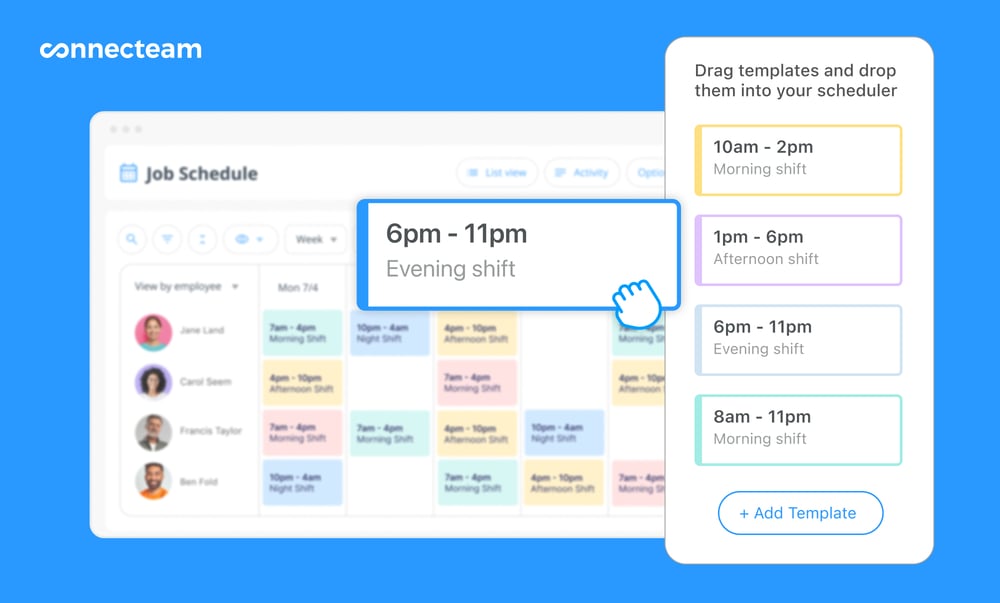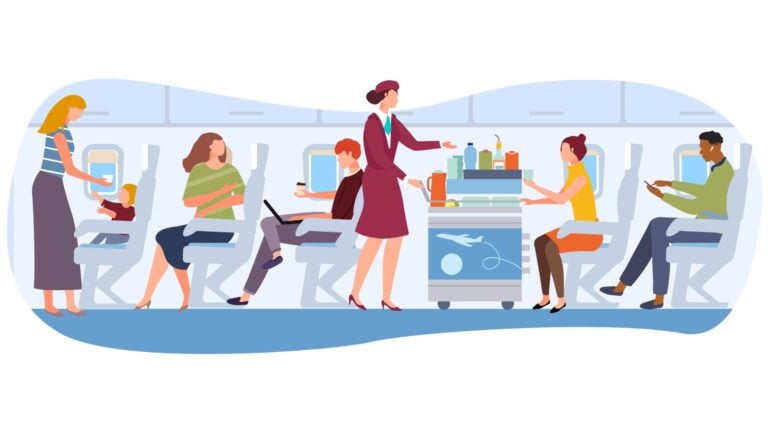Flight attendants are essential to airline operations, handling everything from safety protocols and emergency preparedness to customer service and cabin cleanliness. Their schedules fluctuate and are anything but routine, often involving long hours and extended layovers.
Forget the standard 9-5 workweek; flight attendants trade a traditional schedule for the thrill of an unpredictable schedule split up by layovers in different (and perhaps exotic) locations.
This type of scheduling is crucial for the aviation industry, which is subject to delays and cancellations. Working in aviation means you’re ready for a fast-paced, dynamic, and oftentimes unpredictable way of life.
In this article, we’re covering flight attendant responsibilities, how their schedules work, and Federal Aviation Administration (FAA) regulations they’re required to follow.
What Do Flight Attendants Do?
If you’ve ever flown on a plane, you’ve seen flight attendants in action. However, their training goes far beyond safety demonstrations and serving drinks. Flight attendants play a crucial role in the aviation industry, and commercial airlines couldn’t operate without them.
Flight attendant responsibilities include:
- Emergency preparedness: Be ready to handle emergencies, including medical situations, evacuations, and unruly passengers.
- Passenger assistance: Help passengers with special needs, such as the elderly, disabled, or those traveling with young children.
- Pre-flight checks: Inspect emergency equipment, ensure the cabin is secure, and verify that food and drink supplies are stocked.
- Safety demonstrations: Show passengers how to use safety equipment, such as seat belts, oxygen masks, and life vests.
- Customer service: Address passenger questions, concerns, and complaints to ensure a pleasant flying experience.
- Food and beverage service: Serve meals, snacks, and drinks to passengers.
- Cabin cleanliness: Maintain the cleanliness of the cabin, including restocking supplies and cleaning up spills.
- Security measures: Monitor the cabin for suspicious activity and ensure the security of the aircraft.
- Passenger safety: Ensure passengers comply with safety regulations, such as wearing seat belts and stowing luggage properly.
- Communication: Relay information from the cockpit to passengers, including flight updates, turbulence warnings, and landing preparations
- First aid: Provide medical assistance to passengers who become ill or injured during the flight.
- Post-flight duties: Assist passengers with deplaning, check the cabin for left items, and report any incidents or issues to the airline.
While all flight attendants share core responsibilities, certain roles come with additional duties and responsibilities.
- Purser: Often seen as the head of the cabin crew, the purser oversees the overall cabin operations. They handle administrative tasks, manage the crew, and ensure passenger comfort and safety. Pursers usually have several years of flight attendant experience.
- Lead Flight Attendant: Similar to the purser, a lead flight attendant supervises the cabin crew and ensures smooth operations. They may have additional responsibilities based on the airline’s structure.
Other roles may include:
- In-flight Service Manager: Responsible for overseeing the overall passenger experience, including meal service, beverage options, and onboard retail.
- Senior Flight Attendant: A more experienced flight attendant who assists the purser or lead flight attendant and often handles complex passenger issues.
It’s important to note that the specific titles and responsibilities can vary significantly between airlines.
Training and Certification
Flight attendant training typically lasts between 4-8 weeks and combines both physical and classroom learning. Training covers safety drills, customer service training, emergency procedures, and first aid. After initial training, flight attendants must pass a series of tests to receive their certification. Ongoing training is also required to keep up with new regulations and procedures.
Career Progression
Flight attendants can progress in their careers by gaining additional qualifications or certifications, such as advanced safety training or foreign language proficiency. Career paths may include becoming a purser, lead flight attendant, or moving into management roles within the airline industry.
Flight Attendant Schedules
There is no “normal” schedule for flight attendants. Unlike a typical office job, flight attendants may work unpredictable hours, split shifts, layovers, and varying work weeks.
Reserve vs. line holder schedules
Which shifts flight attendants work is heavily influenced by seniority. Typically, less senior flight attendants work reserve schedules, while those with more experience work line holder schedules.
Here’s the difference between the two.
- Reserve Flight Attendants: Don’t have set schedules. They have to be on call 24 hours a day and ready to cover last-minute trips due to cancellations, sick calls, or other operational needs. Shifts can be unpredictable and usually involve long work stretches and layovers.
- Line Holder Flight Attendants: More experienced flight attendants work line holder schedules, which allows them to have more preference over the shifts they work. Line holders can choose the shifts they want based on days, hours, or destinations, and can swap or drop shifts, too.
Hours and schedules
On average, flight attendants work 12-14 days a month and log 65-85 flight hours, but their day-to-day vary based on the number of flights they have scheduled, flight lengths, and flight routes.
3 types of flight attendant schedules include:
- Turns: A turn, also known as a turnaround, is a flight schedule where a flight attendant works a round trip within a single day without staying overnight at the flight destination. They depart from their home base, fly to the destination, and return to the home base the same day.
- 2-day trips: A 2-day trip is when a flight attendant works 2 consecutive days in a row. They typically fly to a destination on the first day, stay overnight, and then return to their home base or proceed to another destination the following day.
- Long haul trips: Long haul trips involve flights that cover long distances, typically international routes that can last several hours or more. These trips often include extended layovers in distant cities, allowing flight attendants to rest before the return journey or continuing to another destination. Long haul trips can vary in duration, sometimes extending over several days.
Flight Attendant Scheduling Restrictions
The FAA mandates rest requirements to ensure flight attendant health and safety.
Flight attendants are more prone to fatigue and health issues due to fluctuating schedules, working night shifts, and jetlag. In fact, 71% of cabin crew believe their fatigue affects their safety-related performance.
Therefore, the FAA requires them to adhere to the following:
- Flight attendants must take a rest period of at least 9 consecutive hours for work periods exceeding 14 hours.
- For work periods longer than 18 hours, a rest period of 12 hours is required.
- Flight attendants can take 8-hour rest periods only if a scheduled 10-hour rest takes place within 24 hours.
The FAA mandates a specific number of flight attendants based on the number of passengers to ensure flight attendants take rest periods during flights.
To combat the effects of erratic schedules and fatigue, airlines should implement health and wellness initiatives to ensure the well-being of cabin crew and maintain high safety standards.
This may include:
- Providing adequate rest periods
- Offering wellness programs
- Using technology to better manage and monitor crew schedules to minimize the impact of irregular hours and long flights
Did You Know?
With Connecteam’s employee scheduler, you can:
- Create and manage complex flight attendant schedules with ease.
- Use the AI scheduler to assign open shifts based on availability, preferences, and qualifications.
- Share schedules instantly with your crew, accessible from their mobile devices.
- Allow flight attendants to swap shifts and pick up new ones from anywhere in the world.
- Ensure compliance with FAA rest requirements using built-in alerts and scheduling rules.
- Track flight attendant hours and manage payroll seamlessly.

FAQ
How much do flight attendants earn?
Flight attendants work on an hourly basis, earning an average of $42/hour or $86,370/year as of June 2024.
What kind of training is required for flight attendants?
Flight attendant training typically lasts between 4-8 weeks and combines both physical and classroom learning. Training covers
When do flight attendants get paid?
Interestingly enough, flight attendant time clocks don’t start until passengers are seated and the aircraft doors close.
However, in June 2022, Delta Airlines began paying cabin crews during boarding, a significant move that increased flight attendant pay by several thousands of dollars a year.


